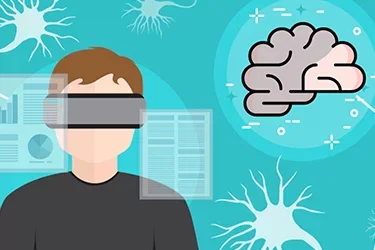The Orchestra in Your Brain
Virtual Reality And Neurophysics
Neurophysics Exploration at UCLA
In the laboratory of Dr. Mayank Mehta, researchers are exploring a very different paradigm on learning and memory that has produced some intriguing insights.

Dr. Mehta, a professor in the departments of physics and astronomy, neurology and neurobiology, begins with a basic observation: Brain function is astonishingly complex because billions of molecules interact in specific ways to produce even the most mundane brain functions. Instead of examining the DNA of neurons or tracking specific neural pathways, Dr. Mehta's research team is looking at the behavior of huge ensembles of neurons to discover the unique patterns and rhythms that produce specific behaviors, such as walking to the refrigerator and opening the door.
That act, opening the refrigerator door, is a concrete action driven by billions of neurons acting in concert. Thus, Dr. Mehta calls this analytic approach "neurophysics" because it essentially seeks to understand how the "mind" arises from physical matter that makes up the brain.
This is a new kind of science that looks at the collective behavior of the whole ensemble, if we don't understand this symphony in the brain we won't know when it goes wrong and how to fix it.
Neural Ensembles
In his lab, Dr. Mehta and his team measure the activity of ensembles of isolated neurons from various parts of the hippocampus—where learning and memory functions take place—during learning and during sleep. They use complex mathematical models and analytical tools to decipher the patterns of neural activity and field potentials (the electrical field surrounding neurons) and their relationship to behavior.
"There are 100 billion neurons, and a billion may be active at the same time," he explains. "These activity patterns are mind-bogglingly complicated. So the classic challenge is to figure out what are the relationships between these jiggling of atoms and molecules in the brain and how does that result in observable properties—or emergent properties?" Understanding neural ensemble dynamics could point to novel ways of treating learning and memory disorders and other brain-based diseases. Recent technological advances make neurophysics attainable, but even better techniques are needed, something Dr. Mehta's team is working to develop.
"Before, people had trouble recording even one neuron at a time, let alone 100," he says. "But people are learning to record more neurons at the same time. That means we need this more emergent approach."

Virtual Reality in Neural Research
He is also working on next-generation virtual reality technology to advance his current studies on learning and memory. In recent years, Dr. Mehta and his team have made headlines in neuroscience through their use of virtual reality technology to study the neural mechanisms involved in spatial navigation.
While that sounds like a project for the crew of Star Trek, the researchers devised an experiment in which a rodent's neural activity is tracked (using tiny microelectrodes inserted in the brain) while it runs on a treadmill-like device with movie-like images projected around the animal to create a virtual reality setting.
The experiment attempts to look at how the brain perceives space and time and capitalizes on the 1971 discovery that the brain possesses a special class of neurons called "place cells" which fire in response to specific physical locations. For example, as you walk to the refrigerator to open the door, specific place cells fire in a uniquely orchestrated pattern with every step and action. Researchers believe place cells fire based on visual cues, locomotion cues (how the body is moving through space) and proximal cues, which means things like odor or temperature or touch.
In the virtual reality experiment, researchers took away both motion cues and proximal cues to see how the animals' place cells would respond—and they found surprising alternations. About 60 percent of the place cells became inactive during the virtual reality experiment, when they had access to only visual landmarks, compared to the activity pattern seen when the rats were moving about in the real world using all available cues. Moreover, without motion and proximal cues, the place cells seemed to lose their ability to track space accurately.
In other words, the rat's cognitive map had changed completely. This implies a unique flexibility of the learning systems in the brain's hippocampus and suggests what might be happening when disease processes set in. For example, one of the early signs of Alzheimer's disease is getting lost when trying to navigate even very familiar routes, such as driving home from the neighborhood grocery store.
Neurons do not fire randomly like popcorn popping in a pan. Groups of neurons become active or fall silent at the same time, a phenomenon Dr. Mehta calls neural rhythms. Neural ensembles produce "languages" and "rhythms" that must be deciphered to understand the mind. Just like an out-of-tune violin disrupts the sound produced by an orchestra, a small disruption in the rhythm of neuronal ensembles may trigger brain dysfunction and disease.
"We are finding that when neurons are talking to each other they are acting like a complex musical piece," Dr. Mehta says. "Our techniques of measuring the activity of neurons with very high precision and then applying mathematical models allows us to decipher these rhythms. While the research is performed in animals now, future studies could be safely conducted in humans using nanotechnology and microelectrodes.
"The power of the neurophysics approach is that a simple question like 'Where you are in space?' leads to all kinds of amazing insights," he says. "By doing this kind of research from the ground up, the promise is you'll end up not just solving one disease but maybe a whole lot of them."